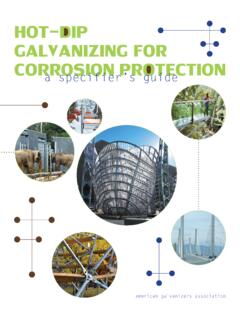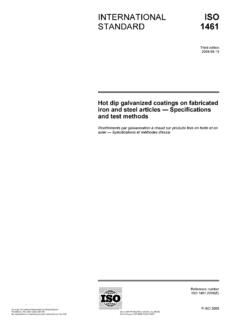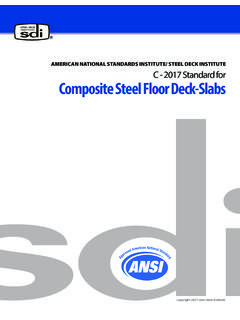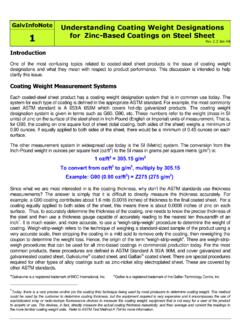Transcription of ZINC COATINGS - American Galvanizers Association
1 A Comparative Analysis of Process and Performance CharacteristicsZINC COATINGSZINC COATINGSZINC COATINGSA merican Galvanizers AssociationAmerican Galvanizers 2011 American Galvanizers Association . The material provided herein has been developed to provide accurate and authoritative information about after-fabrication hot-dip galvanized steel . This material provides general information only and is not intended as a substitute for competent professional examination and verification as to suitability and applicability. The information provided herein is not intended as a representation or warranty on the part of the AGA.
2 Anyone making use of this information assumes all liability arising from such 1 BATCH HOT-DIP GALVANIZING 2 CONTINUOUS SHEET GALVANIZING 4 zinc PAINTING 6 zinc SPRAY METALLIZING 7 MECHANICAL PLATING 8 ELECTROGALVANIZING 9 zinc PLATING 10 SELECTION OF zinc COATINGS 10 CONCLUSION 11 zinc COATINGS COMPARISON 12 ACKNOWLEDGEMENTS 13 Contents1 INTRODUCTIONINTRODUCTIONINTRODUCTIONZinc , a natural, healthy, and abundant element was first used in construction in 79 AD; thus, its characteristics as a well-suited corrosion protective coating for iron and steel products has long been known.
3 The 27th most abundant element in the Earth s crust, zinc is naturally present in rocks, soil, air, water, and the biosphere, as well as in plants, animals, and humans. In fact, zinc is essential to life as all organisms require it to survive and complete normal physiological functions. Today, more than 13 million tons of zinc are produced annually worldwide, 70% from mined ores, and 30% from recycled sources. More than half of the annual production is used in zinc COATINGS to protect steel from corrosion.
4 Because zinc is an infinitely recyclable material, the level of recycling increases each year, and currently 80% of the zinc available for recycling is indeed reclaimed. However, because of zinc s excellent field performance as a corrosion protection coating , it often remains in service for generations before recycling. zinc , like all metals, corrodes when exposed to the atmosphere. However, because of its ability to form dense, adherent corrosion byproducts, the rate of corrosion is considerably lower than ferrous materials (10 to 100 times slower depending on the environment).
5 zinc corrosion products develop naturally on the surface as the coating is exposed to natural wet and dry cycles in the atmosphere and are often referred to as the zinc patina. The zinc patina acts as an additional barrier between the steel and the environment. In addition to the natural barrier protection of the coating and patina, zinc also protects the base steel cathodically. The Galvanic Series of Metals (Figure 1) lists metals in order of their electrochemical potential in the presence of salt water. When two metals are connected, those higher on the list will become anodic and preferentially corrode to protect metals lower in the series.
6 Therefore, zinc is anodic to steel and will sacrificially corrode to protect the underlying steel from corrosion. There are a number of zinc COATINGS which are often generically termed galvanizing, but each has unique characteristics. These characteristics not only affect applicability, but also economics and performance in the environment. The method of application, adhesion to the base metal, hardness, corrosion resistance, and thickness (Figure 2) of each zinc coating practical aid examines the following zinc COATINGS : batch hot-dip galvanizing, continuous sheet galvanizing, zinc painting, zinc spray metallizing, mechanical plating, electrogalvanizing, and zinc plating.
7 To help architects, engineers, and other specifiers assess and select the most suitable zinc coating for corrosion GalvanizedZinc PaintGalvanized SheetElectroplatedMetallized1 milFigure 1: Cathodic Protection from ZincArrangement of Metals in Galvanic Series CORRODED END: Anodic or less noble (ELECTRONEGATIVE) Magnesium zinc Aluminum steel Lead Tin Nickel Brass Bronzes Copper Stainless steel (passive) Silver Gold Platinum PROTECTED END: Cathodic or More Noble (ELECTROPOSITIVE)Cathodic protection can occur when two metals are electrically connected.
8 Any one of these metals and alloys will theoretically corrode while offering protection to any other which is lower in the series, so long as both are electrically connected. However, in actual practice, zinc is by far the most effective in this 2: Microstructures of Various zinc COATINGS 2 American Galvanizers AssociationCoating Characteristics and PerformanceThe batch hot-dip galvanized coating consists of a series of zinc -iron alloy layers with a surface layer of pure zinc (Figure 4). The unique intermetallic layers are tightly bonded (3,600 psi) to and harder than the base steel , offering excellent abrasion resistance.
9 The zinc -iron alloy layers are metallurgically bonded to the steel ; and thus, become an integral part of the steel rather than just a surface coating . Furthermore, as mentioned previously, zinc is anodic to steel ; therefore, even if the durable intermetallic layers of the hot-dip galvanized coating are damaged (up to in diameter) adjacent zinc will sacrificially protect the exposed steel until all of the surrounding zinc is consumed. Another unique characteristic of the batch hot-dip galvanized coating is its uniform, complete coverage.
10 During the diffusion reaction in the kettle, the zinc -iron alloy layers grow perpendicular to all surfaces, ensuring edges, corners, and threads have coating equal to or greater than flat surfaces. Additionally, because hot-dip galvanizing is a total immersion process, all interior surfaces of hollow structures and difficult to access recesses of complex pieces are coated. This complete, uniform coverage means critical points where corrosion commonly occurs are afforded the same protection as accessible flat, exterior surfaces.
















